Effect of Different Soft Segment Contents on the Energy Storage Capacity and Photo–Thermal Performance of Polyurethane-Based/Graphene Oxide Composite Solid–Solid Phase Change Materials
Abstract
1. Introduction
2. Experimental Section
2.1. Materials
2.2. Preparation of GO
2.3. Synthesis of PU/GO Composites
2.4. Characterization
3. Results and Discussion
3.1. The Chemical and Structural Analysis of PCMs
3.2. Micromorphology Analysis of PCMs
3.3. Thermophysical Properties of PCMs
3.3.1. Thermophysical Properties of PU/GO
3.3.2. Thermal Stability of PU/GO
3.3.3. Thermal Transfer Property of PU/GO
3.4. Photo–Thermal Energy Conversion
4. Conclusions
Author Contributions
Funding
Institutional Review Board Statement
Conflicts of Interest
References
- Wang, Z.; Tong, Z.; Ye, Q.; Hu, H.; Nie, X.; Yan, C.; Shang, W.; Song, C.; Wu, J.; Wang, J.; et al. Dynamic tuning of optical absorbers for accelerated solar-thermal energy storage. Nat. Commun. 2017, 8, 1478. [Google Scholar] [CrossRef] [PubMed]
- Liu, H.; Wang, X.; Wu, D. Innovative design of microencapsulated phase change materials for thermal energy storage and versatile applications: A review. Sustain. Energy Fuels 2019, 3, 1091–1149. [Google Scholar] [CrossRef]
- Khan, Z.; Khan, Z.; Ghafoor, A. A review of performance enhancement of PCM based latent heat storage system within the context of materials, thermal stability and compatibility. Energy Convers. Manag. 2016, 115, 132–158. [Google Scholar] [CrossRef]
- Hu, J.; Yu, H.; Chen, Y.; Zhu, M. Study on phase-change characteristics of PET-PEG copolymers. J. Macromol. Sci. Part B 2006, 45, 615–621. [Google Scholar] [CrossRef]
- Chen, R.; Yao, R.; Xia, W.; Zou, R. Electro/photo to heat conversion system based on polyurethane embedded graphite foam. Appl. Energy 2015, 152, 183–188. [Google Scholar] [CrossRef]
- Guo, J.; Xiang, H.; Wang, Q.; Hu, C.; Zhu, M.; Li, L. Preparation of poly(decaglycerol-co-ethylene glycol) copolymer as phase change material. Energy Build. 2012, 48, 206–210. [Google Scholar] [CrossRef]
- Tong, X.; Li, N.; Zeng, M.; Wang, Q. Organic phase change materials confined in carbon-based materials for thermal properties enhancement: Recent advancement and challenges. Renew. Sustain. Energy Rev. 2019, 108, 398–422. [Google Scholar] [CrossRef]
- Stropnik, R.; Koželj, R.; Zavrl, E.; Stritih, U. Improved thermal energy storage for nearly zero energy buildings with PCM integration. Sol. Energy 2019, 190, 420–426. [Google Scholar] [CrossRef]
- Liu, G.; Rumyantsev, S.; Shur, M.S.; Balandin, A.A. Origin of 1/f noise in graphene multilayers: Surface vs. volume. Appl. Phys. Lett. 2013, 102, 093111. [Google Scholar] [CrossRef]
- Wang, F.; Ling, Z.; Fang, X.; Zhang, Z. Optimization on the photo-thermal conversion performance of graphite nanoplatelets decorated phase change material emulsions. Sol. Energy Mater. Sol. Cells 2018, 186, 340–348. [Google Scholar] [CrossRef]
- Tang, L.-S.; Yang, J.; Bao, R.-Y.; Liu, Z.-Y.; Xie, B.-H.; Yang, M.-B.; Yang, W. Polyethylene glycol/graphene oxide aerogel shape-stabilized phase change materials for photo-to-thermal energy conversion and storage via tuning the oxidation degree of graphene oxide. Energy Convers. Manag. 2017, 146, 253–264. [Google Scholar] [CrossRef]
- Qi, G.-Q.; Liang, C.-L.; Bao, R.-Y.; Liu, Z.-Y.; Yang, W.; Xie, B.-H.; Yang, M.-B. Polyethylene glycol based shape-stabilized phase change material for thermal energy storage with ultra-low content of graphene oxide. Sol. Energy Mater. Sol. Cells 2014, 123, 171–177. [Google Scholar] [CrossRef]
- Diez-Pascual, A.M.; Diez-Vicente, A.L. Poly(propylene fumarate)/Polyethylene Glycol-Modified Graphene Oxide Nanocomposites for Tissue Engineering. ACS Appl. Mater. Interfaces 2016, 8, 17902–17914. [Google Scholar] [CrossRef] [PubMed]
- He, L.; Wang, H.; Zhu, H.; Gu, Y.; Li, X.; Mao, X. Thermal Properties of PEG/Graphene Nanoplatelets (GNPs) Composite Phase Change Materials with Enhanced Thermal Conductivity and Photo-Thermal Performance. Appl. Sci. 2018, 8, 2613. [Google Scholar] [CrossRef]
- Yang, J.; Qi, G.-Q.; Liu, Y.; Bao, R.-Y.; Liu, Z.-Y.; Yang, W.; Xie, B.-H.; Yang, M.-B. Hybrid graphene aerogels/phase change material composites: Thermal conductivity, shape-stabilization and light-to-thermal energy storage. Carbon 2016, 100, 693–702. [Google Scholar] [CrossRef]
- Li, M.; Wang, C. Preparation and characterization of GO/PEG photo-thermal conversion form-stable composite phase change materials. Renew. Energy 2019, 141, 1005–1012. [Google Scholar] [CrossRef]
- Jiang, Y.; Wang, Z.; Shang, M.; Zhang, Z.; Zhang, S. Heat collection and supply of interconnected netlike graphene/polyethyleneglycol composites for thermoelectric devices. Nanoscale 2015, 7, 10950–10953. [Google Scholar] [CrossRef]
- Chen, C.; Liu, W.; Wang, Z.; Peng, K.; Pan, W.; Xie, Q. Novel form stable phase change materials based on the composites of polyethylene glycol/polymeric solid-solid phase change material. Sol. Energy Mater. Sol. Cells 2015, 134, 80–88. [Google Scholar] [CrossRef]
- Sundararajan, S.; Samui, A.B.; Kulkarni, P.S. Synthesis and characterization of poly(ethylene glycol) (PEG) based hyperbranched polyurethanes as thermal energy storage materials. Thermochim. Acta 2017, 650, 114–122. [Google Scholar] [CrossRef]
- Lu, X.; Fang, C.; Sheng, X.; Zhang, L.; Qu, J. One-Step and Solvent-Free Synthesis of Polyethylene Glycol-Based Polyurethane As Solid–Solid Phase Change Materials for Solar Thermal Energy Storage. Ind. Eng. Chem. Res. 2019, 58, 3024–3032. [Google Scholar] [CrossRef]
- Pielichowska, K.; Nowak, M.; Szatkowski, P.; Macherzyńska, B. The influence of chain extender on properties of polyurethane-based phase change materials modified with graphene. Appl. Energy 2016, 162, 1024–1033. [Google Scholar] [CrossRef]
- Zhou, Y.; Liu, X.; Sheng, D.; Lin, C.; Ji, F.; Dong, L.; Xu, S.; Wu, H.; Yang, Y. Polyurethane-based solid-solid phase change materials with in situ reduced graphene oxide for light-thermal energy conversion and storage. Chem. Eng. J. 2018, 338, 117–125. [Google Scholar] [CrossRef]
- Feng, L.; Zheng, J.; Yang, H.; Guo, Y.; Li, W.; Li, X. Preparation and characterization of polyethylene glycol/active carbon composites as shape-stabilized phase change materials. Sol. Energy Mater. Sol. Cells 2011, 95, 644–650. [Google Scholar] [CrossRef]
- Su, J.-C.; Liu, P.-S. A novel solid–solid phase change heat storage material with polyurethane block copolymer structure. Energy Convers. Manag. 2006, 47, 3185–3191. [Google Scholar] [CrossRef]
- Li, Y.; Liu, R.; Huang, Y. Synthesis and phase transition of cellulose-graft-poly(ethylene glycol) copolymers. J. Appl. Polym. Sci. 2008, 110, 1797–1803. [Google Scholar] [CrossRef]
- Marcano, D.C.; Kosynkin, D.V.; Berlin, J.M.; Sinitskii, A.; Sun, Z.; Slesarev, A.; Alemany, L.B.; Lu, W.; Tour, J.M. Improved Synthesis of Graphene Oxide. ACS Nano 2010, 4, 4806–4814. [Google Scholar] [CrossRef]
- Zheng, F.; Jiang, P.; Hu, L.; Bao, Y.; Xia, J. Functionalization of graphene oxide with different diisocyanates and their use as a reinforcement in waterborne polyurethane composites. J. Macromol. Sci. Part A 2019, 56, 1071–1081. [Google Scholar] [CrossRef]
- Saha, U.; Jaiswal, R.; Singh, J.P.; Goswami, T.H. Diisocyanate modified graphene oxide network structure: Steric effect of diisocyanates on bimolecular cross-linking degree. J. Nanoparticle Res. 2014, 16, 1–21. [Google Scholar] [CrossRef]
- Yu, W.; Sisi, L.; Haiyan, Y.; Jie, L. Progress in the functional modification of graphene/graphene oxide: A review. RSC Adv. 2020, 10, 15328–15345. [Google Scholar] [CrossRef]
- Sun, Y.; He, C. Synthesis and Stereocomplex Crystallization of Poly(lactide)–Graphene Oxide Nanocomposites. ACS Macro Lett. 2012, 1, 709–713. [Google Scholar] [CrossRef]
- Yuan, J.; Qian, X.; Meng, Z.; Yang, B.; Liu, Z.-Q. Highly Thermally Conducting Polymer-Based Films with Magnetic Field-Assisted Vertically Aligned Hexagonal Boron Nitride for Flexible Electronic Encapsulation. ACS Appl. Mater. Interfaces 2019, 11, 17915–17924. [Google Scholar] [CrossRef] [PubMed]


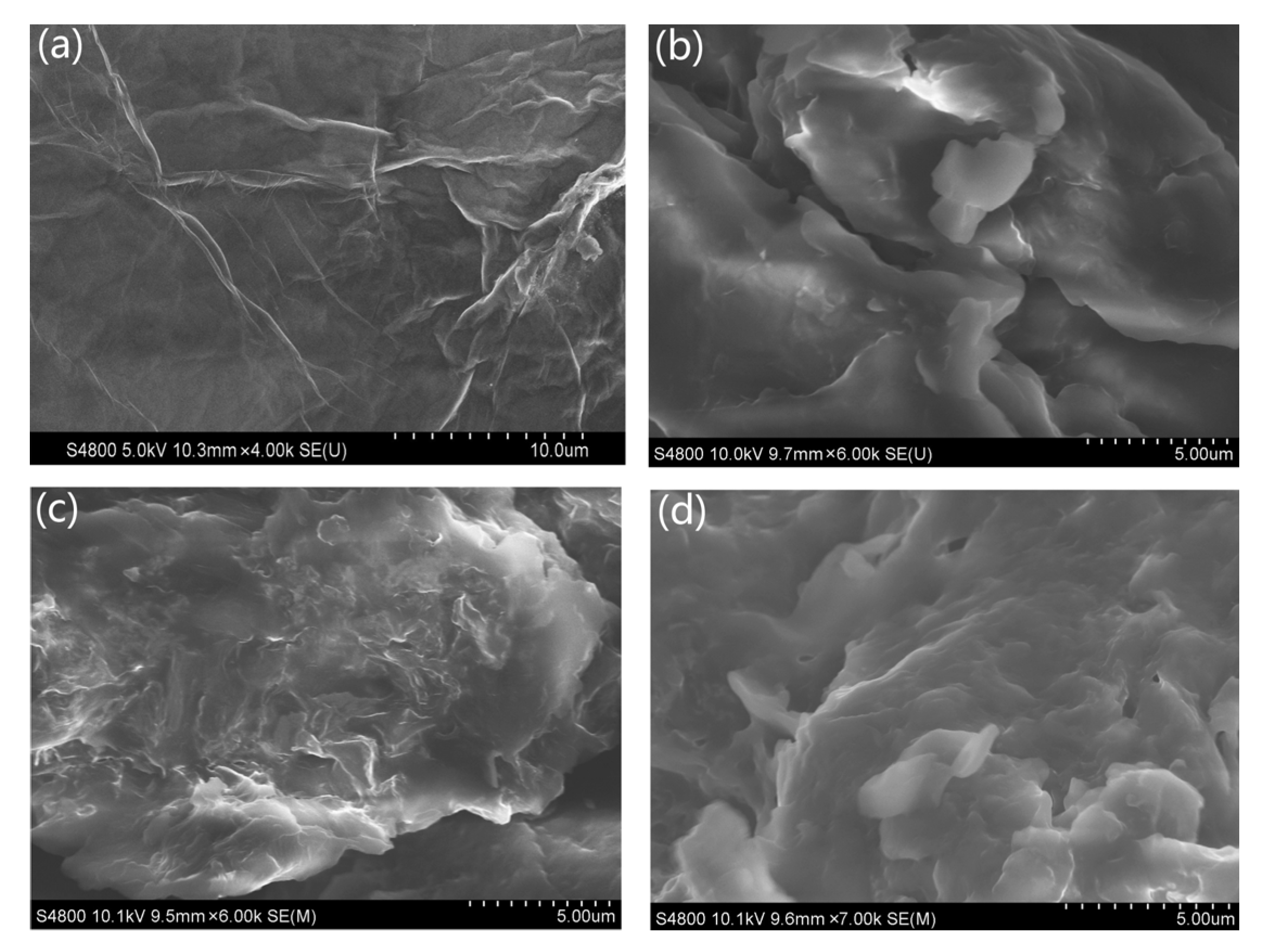
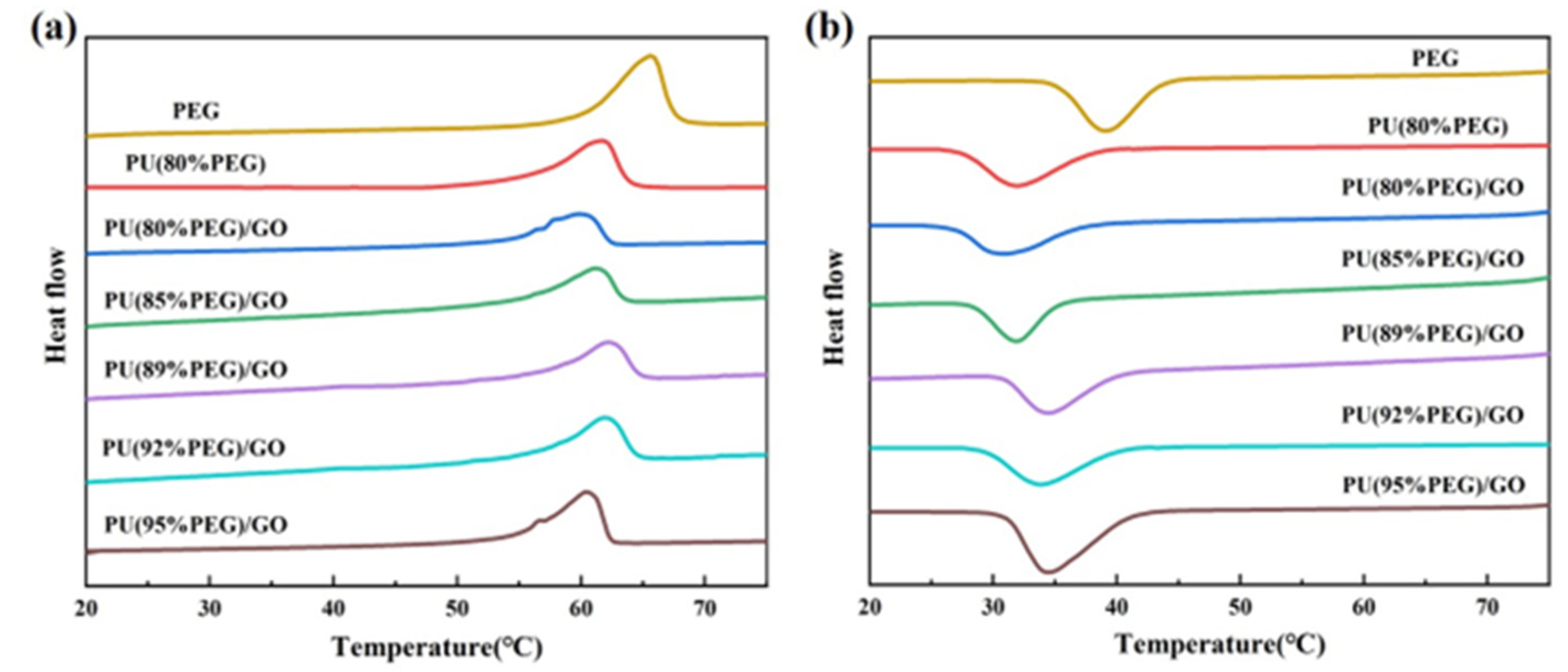
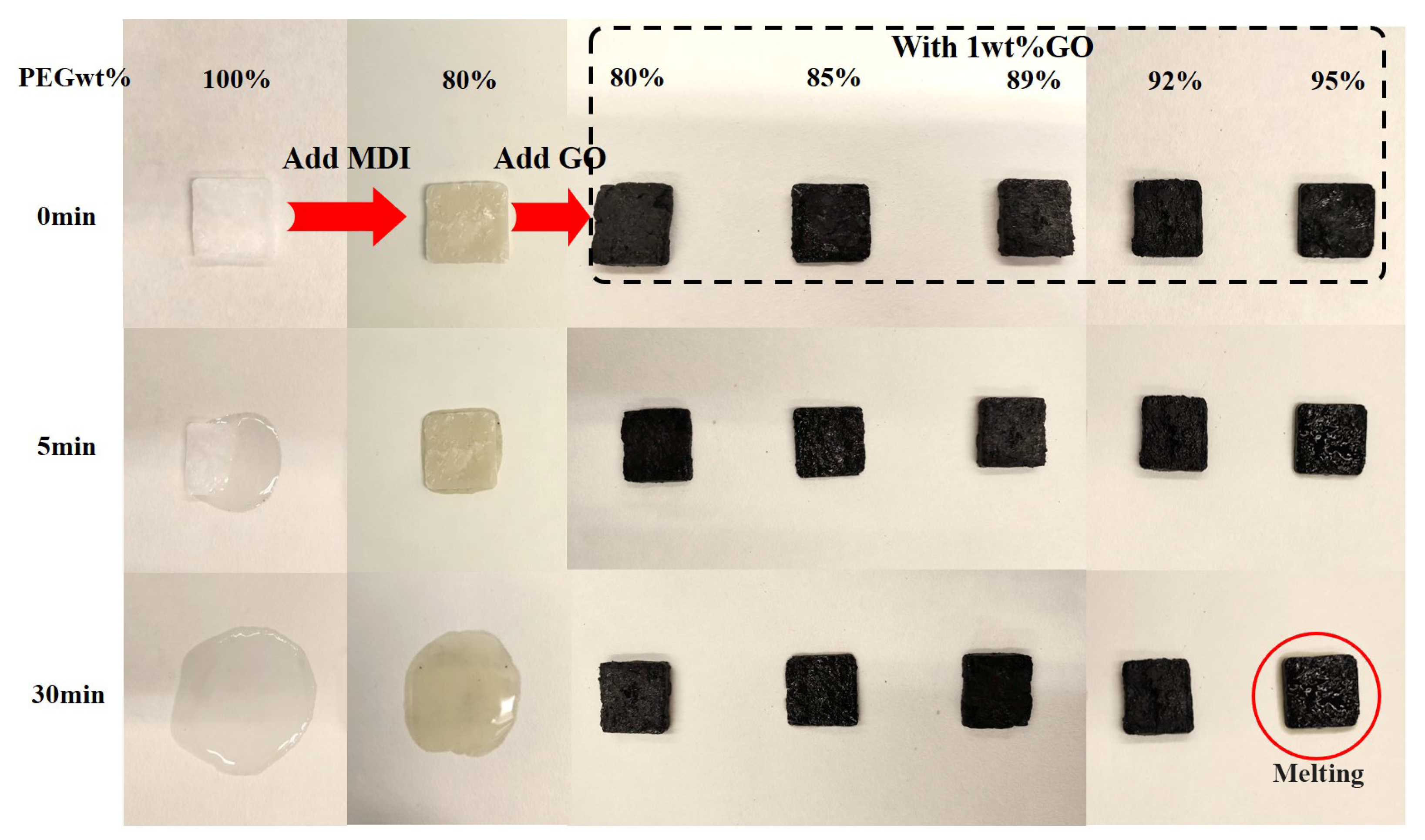

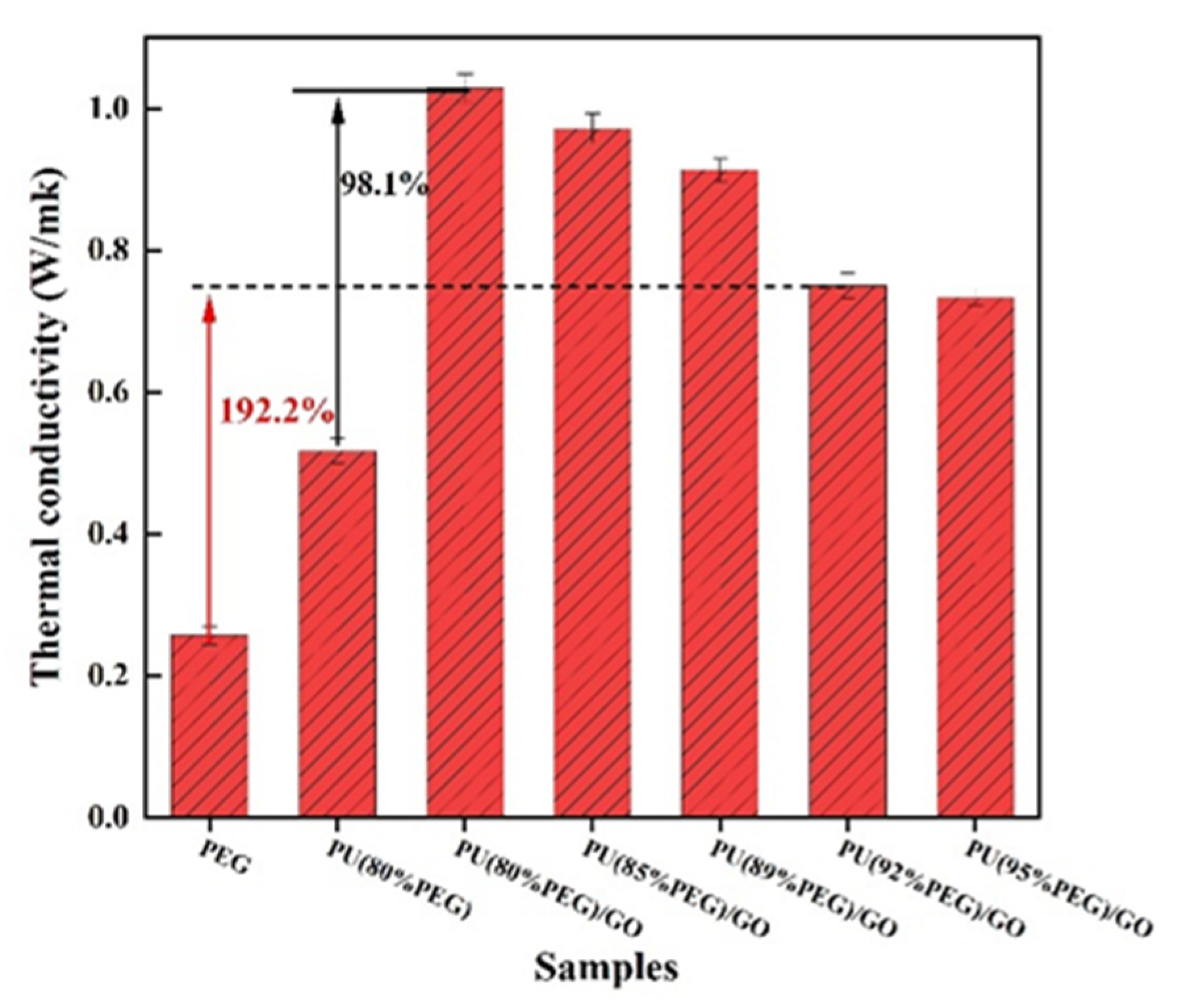
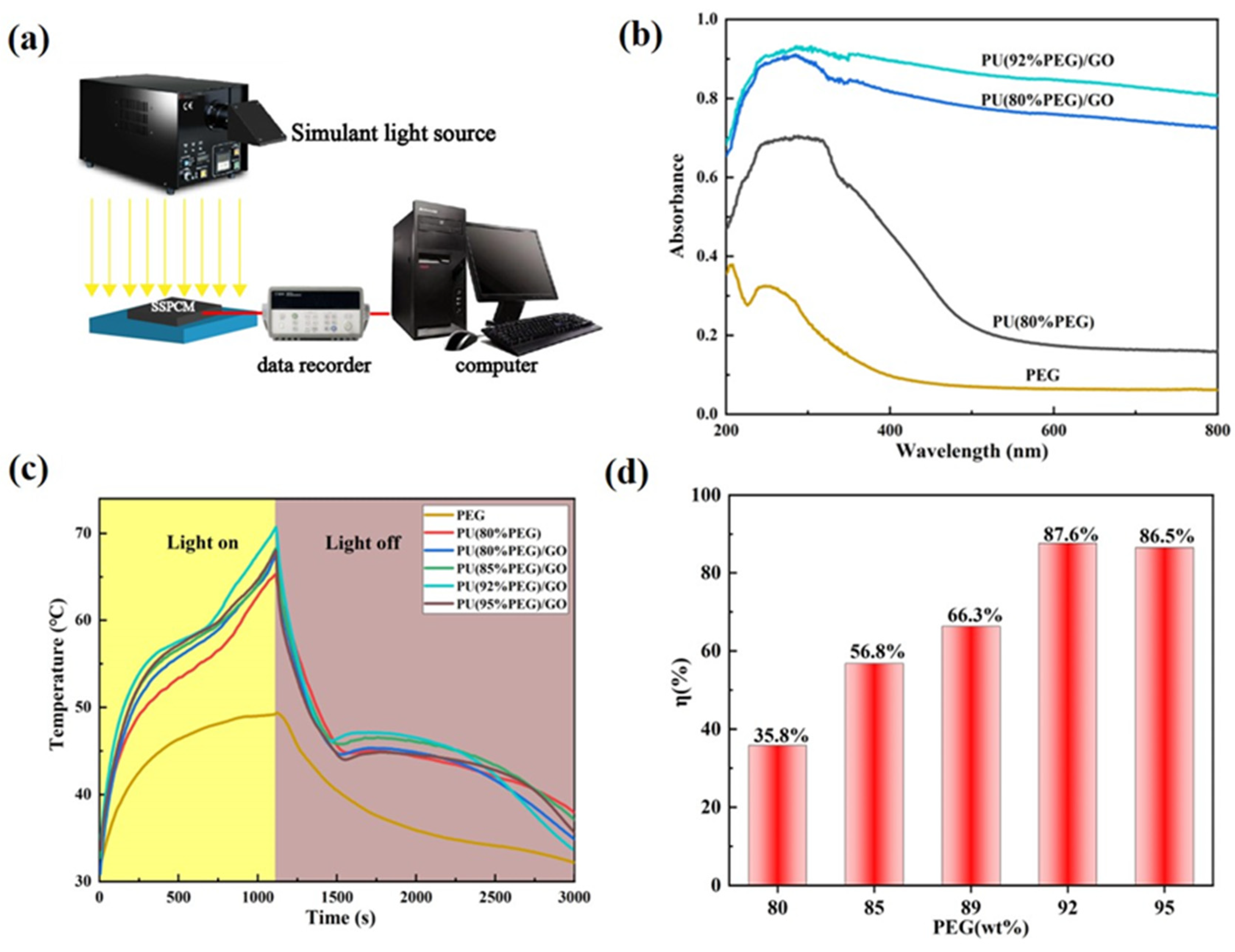
| Compositions | Samples | PEG (wt%) | GO (wt%) |
|---|---|---|---|
| PEG | PEG | 100 | 0 |
| PU | PU(80%PEG) | 80 | 1 |
| PU/GO | PU(80%PEG)/GO | 80 | 1 |
| PU(85%PEG)/GO | 85 | 1 | |
| PU(89%PEG)/GO | 89 | 1 | |
| PU(92%PEG)/GO | 92 | 1 | |
| PU(95%PEG)/GO | 95 | 1 |
| GO | PEG | PU(80%PEG) | PU(80%PEG)/GO | PU(92%PEG)/GO | |
|---|---|---|---|---|---|
| Vibration bands | Wavenumber (cm−1) | ||||
| N-H stretching | - | - | 3316 | 3309 | 3304 |
| C=O stretching | 1638 | - | 1635 | 1640 | 1647 |
| C-O stretching | 1092 | 1099 | 1106 | 1105 | 1102 |
| Samples | GO (wt%) | PEG (wt%) | (°C) | Xc (%) | |||
|---|---|---|---|---|---|---|---|
| PEG | 0 | 100 | 65.13 | 39.33 | 174.6 | 169.2 | 100 |
| PU(PEG80%) | 0 | 80 | 61.84 | 32.77 | 103.62 | 97.98 | 74.2 |
| PU(PEG80%)/GO | 1 | 80 | 60.01 | 30.88 | 92.41 | 89.48 | 66.2 |
| PU(PEG85%)/GO | 1 | 85 | 61.26 | 31.82 | 111.7 | 103.7 | 75.3 |
| PU(PEG89%)/GO | 1 | 89 | 62.42 | 34.45 | 124.13 | 116.08 | 79.9 |
| PU(PEG92%)/GO | 1 | 92 | 61.81 | 33.67 | 138.12 | 129.14 | 86.0 |
| PU(PEG95%)/GO | 1 | 95 | 61.39 | 34.06 | 157.43 | 151.32 | 94.9 |
| Samples | Temperature at 5% Weight Loss (°C) | Temperature at 10% Weight Loss (°C) | Maximum Weight Loss (%) |
|---|---|---|---|
| PEG | 385 | 400 | 97.2 |
| PU(PEG80%) | 343 | 387 | 86.2 |
| PU(PEG80%)/GO | 344 | 375 | 83.8 |
| PU(PEG85%)/GO | 353 | 385 | 84.1 |
| PU(PEG89%)/GO | 365 | 391 | 85.1 |
| PU(PEG92%)/GO | 379 | 395 | 85.7 |
| PU(PEG95%)/GO | 379 | 396 | 88.5 |
Publisher’s Note: MDPI stays neutral with regard to jurisdictional claims in published maps and institutional affiliations. |
© 2022 by the authors. Licensee MDPI, Basel, Switzerland. This article is an open access article distributed under the terms and conditions of the Creative Commons Attribution (CC BY) license (https://creativecommons.org/licenses/by/4.0/).
Share and Cite
Wang, J.; Wu, Z.; Xie, H.; Wang, T.; Wang, Y.; Huang, Y.; Dong, L. Effect of Different Soft Segment Contents on the Energy Storage Capacity and Photo–Thermal Performance of Polyurethane-Based/Graphene Oxide Composite Solid–Solid Phase Change Materials. Polymers 2022, 14, 5161. https://doi.org/10.3390/polym14235161
Wang J, Wu Z, Xie H, Wang T, Wang Y, Huang Y, Dong L. Effect of Different Soft Segment Contents on the Energy Storage Capacity and Photo–Thermal Performance of Polyurethane-Based/Graphene Oxide Composite Solid–Solid Phase Change Materials. Polymers. 2022; 14(23):5161. https://doi.org/10.3390/polym14235161
Chicago/Turabian StyleWang, Jiawei, Zihua Wu, Huaqing Xie, Tingting Wang, Yuanyuan Wang, Yueming Huang, and Lan Dong. 2022. "Effect of Different Soft Segment Contents on the Energy Storage Capacity and Photo–Thermal Performance of Polyurethane-Based/Graphene Oxide Composite Solid–Solid Phase Change Materials" Polymers 14, no. 23: 5161. https://doi.org/10.3390/polym14235161
APA StyleWang, J., Wu, Z., Xie, H., Wang, T., Wang, Y., Huang, Y., & Dong, L. (2022). Effect of Different Soft Segment Contents on the Energy Storage Capacity and Photo–Thermal Performance of Polyurethane-Based/Graphene Oxide Composite Solid–Solid Phase Change Materials. Polymers, 14(23), 5161. https://doi.org/10.3390/polym14235161









